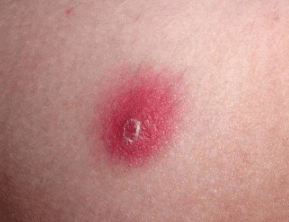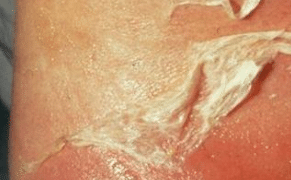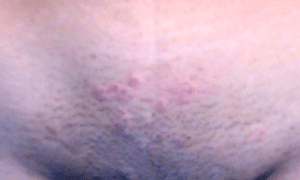How do you get rid of ingrown pubic hairs? How do I get rid of hair around my nipples? How do you keep from getting ingrown hairs? How do you get rid of an ingrown hair? Get more insight on the causes of ingrown hair on breast, pictures, infected, cyst, and treatment
What Causes Ingrown Hair on Breast?
The common causes include:
- Excessive hair growth
There are some unique situations when there is excess hair that is found on the body of females, a condition medically known as hirsutism which can produce very thick hair growth on the upper lips, and even hair on breast especially around the nipples or in the armpits and also hair on the stomach.
This could be due to:
- Male hormone like the testosterone is found in the small amount within the body of all the ladies. Females who have this extra sensitivity will observe extra hair from the onset of puberty which tends to continue until the age of menopause.
- Polycystic Ovarian Syndrome is an endocrine disorder that happens due to hormonal imbalance or changes, causing ovulation problems and also the growth of excess hair on the female body, including the breast hair.
When the ovaries produce a lot of androgens which are the men hormones, the ovaries will then develop many of the cysts and won’t be able to release an egg.
Apart from the hirsutism, other common symptoms of PCOS are irregular periods, weight gain, decreased fertility and depression.
Other severe medical conditions that are associated with PCOS are problems such as diabetes and heart disease. As a result, therefore, PCOS should be treated on time.
- Plucking, waxing and shaving
This is the main cause of ingrown hair is shaving or removing hair. When plucking hairs from the areas around the nipple, it is very vital to take very special care, as this kind of method has been known to really cause ingrown hairs to form on this part of the body.
Take enough time: Rushing through the removal of the hairs from the nipples region and you could place yourself in danger of suffering from ingrown hairs.
- Tight bra or blouse
Rubbing which results to friction is the main cause for ingrown hair around the nipple. Men who wear tight shirts can face a higher chance of suffering from ingrown hairs after shaving or waxing the nipple region.
For women, wearing a tight bra or a blouse that is way very small for your bust can lead to the ingrown hair on the breast skin, breast areola and even on the nipple.
- Shaving with a blunt or dull razor
Using a blunt razor so as to shave the nipple region will not only irritate the sensitive skin of this region but also increase the chances of developing ingrown hair on the breast as well as razor bumps.
- Unsterilized razors may cause ingrown hair cysts
A dirty razor will lead to irritation and also the ingrown hair on the breast to develop, but can also cause spreading of the bacteria to the shaving area.
Unfortunately, most of the people learn the hard way when they have infected pustules and also the bumps because of unsterilized shaving practices. Ingrown hair cysts can also result from dirty razors and poor hygiene after chest hair removal.
- Cushing’s syndrome
This rare hormonal condition can be due to exposure to the high levels of the cortisol hormone which may lead to hirsutism. It can also be as a result of some medications like the corticosteroids such as prednisone which is capable of leading to excess body hair.
This condition may result to:
- Certain rare tumors in the brain or even the adrenal glands should also be considered as a potential cause of the syndrome.
- Cushing syndrome symptoms are very similar to those of the polycystic ovarian syndrome, including the uneven hair distribution and also the nipple hairs.
Any lady who has excess body hair similar to the male pattern should be examined by a qualified doctor so as to make sure that there is not a medical condition leading to the excess growth of body hair
Ingrown Hair On Breast Symptoms
Symptoms may include itchy and tenderness. An ingrown hair can lead to a localized foreign-body inflammatory reaction, which causes the pinpoint red or pink bumps on the skin. Some of the bumps may be slightly red or have an accompanying light-red halo indicating inflammation.
Again, the curled hair can be barely visible at the center of the bump. Small pus bumps or dry red bumps are often scattered over an area that has been shaved recently. Often the bumps start a few days to weeks after hair removal and get worse as the hairs grow back.
People who have ingrown hairs may experience a painful popular eruption after shaving. The upper skin layers may have some dilation of the small superficial blood vessels, which gives the skin a red or flushed appearance.
Pustules may form on the ingrown hair sites due to the infection with common skin bacteria, such as Staphylococcus.
Ingrown Hair On Breast Pictures
An ingrown hair on the breast irritates the skin. It produces a raised, red bump (or cluster of bumps) that looks like a little pimple. Sometimes an ingrown hair can form a painful, boil-like sore.
Ingrown hairs can be itchy and uncomfortable, especially if you’ve got a lot of them. You may notice pus inside the bumps. Or you may see the hair that’s causing the problem.
In men, ingrown hairs often pop up as a bunch of little bumps on the chin, cheeks, chest especially around the breast or neck after shaving.
In women, ingrown hairs are common on the legs, as well as in the pubic area and armpits. You can also get ingrown hairs on your butts.
Ingrown Hair On Breast Lump
These ingrown hairs may produce much raised red spots, which may sometimes be infected and turn into painful, pus-filled sores. Ingrown hairs might be itchy and much embarrassing, but they normally disappear on their own without doing anything.
Anyone is able to get ingrown hair on the breast and nipple, but they, however, tend to be more of a problem in men who have coarse or curly hair.
If possible, then you should leave the ingrown hairs for a while as they can go away without you having to do anything.
Don’t try to pick or even scratch an ingrown hair as the bacteria can enter the small wound created, increasing the risk of infection. It can also lead to scarring.
You should also avoid squeezing of the spots because it may damage the skin and lead to infection.
If an ingrown hair is much near to the surface of the skin, then you could use a sterile needle or even tweezers to gently tease it out. But, don’t dig for the hair if it lies very deep below the skin’s surface.
Men who are much prone to getting ingrown hairs around their face can find it best to grow out their beard. Longer hairs aren’t as sharp at the ends, so are less likely to be an ingrown.
The hair follicles of ingrown hairs can sometimes be infected and also inflamed. This is called folliculitis. The hair follicles can swell into pus-filled spots, although the pus doesn’t always imply there’s an infection.
Again, very mild cases of folliculitis normally clear up on their own without treatment, so try not shaving for a few numbers of days and observe if it gets better. You may also try dabbing a mild antiseptic, like the tea tree oil, on to the affected area.
See the doctor if the spots don’t improve and are much bothering you. If one spot is a problem, the general practitioner is being able to release the ingrown hair by use of a sterile needle.
Antibiotics are normally only required if the skin is severely infected with the pustules and abscesses.
Infected Ingrown Hair On Breast
The hair follicles are meant to erupt and also grow straight out of the skin. Normally, a hair can turn into the channel out of which it is supposed to grow, and it penetrates the skin, leading to swelling as well as the irritation. This can happen due to blockage or with very curly hair.
These are not always a problem unless the hair does not erupt and then leads to an infection (redness, pain, and swelling).
Ingrown hairs normally form pus filled cyst like structures. Sometimes they appear like razor bumps that form about 40 small red bumps around the region where the ingrown hairs have already formed. Flesh-colored red bumps that have a hair shaft in the central part of the shaved areas are observed adjacent to the hair follicle opening.
In these particular areas, pustules and also the abscesses may form especially from the bacterial infection. Sometimes, a chronic or even improperly treated ingrown hairs lead to inflammatory hyperpigmentation, scarring and also the keloid (a rarity) formation.
- This skin condition is mostly observed in darker skin or African skin with facial hair due to the curvature of the patients’ hair follicles.
- The ingrown hair is normally spilled out together with the pus inside. Often it comes with some amount of blood.
Ingrown Hair Cyst On Breast
Cysts may be filled with fluid or other material. There are several types of cysts but the focus is on cysts that relate to the ingrown hair. Ingrown hair cysts on breast and nipple are the small bumps that normally develop under the skin at the place of a hair follicle.
They are usually referred to as hair follicle cysts. Medically, they are known as trichilemmal cyst.
Though it is often confused with the pilonidal cyst (which is the cyst that usually develops at the tailbone), trichilemmal cysts are normally triggered when a hair follicle grows back into the skin instead of it breaking out. The hair follicle or the ingrown cysts are also called by the names Pilar, or isthmus-catagen cyst.
Sometimes, ingrown hair cysts are normally confused with the sebaceous cysts simply due to the fact that both of these do not lead to any infection in the associated area. But, the sebaceous cysts normally appear as small lumps that will appear confined under the trap of the skin or epithelial tissue.
How To Remove Ingrown Hair On Breast .
Here are ways on how to remove ingrown hair on the breast
- Exfoliate
Scrub the ingrown hair gently at least two times a day to get rid of dirt, dead skin cells as well as the oils that have accumulated that can be trapping the ingrown hair.
Exfoliation can also physically jerk the tip of the hair out of the skin while scrubbing around the area to try to come at the hair from a variety of directions to nudge it out.
You will have to exfoliate sufficiently so as to achieve this effect. While scrubbing, try to cover the large area as possible without being too harsh so as to prevent bleeding in the area. Exfoliation is a perfect treatment for the ingrown hair and assists to rid the body of it faster, with very minimum effort.
- Home scrub packs
Home scrub packs are useful treatments for grown hair on nipple and breast area. Make a thick paste of half a teaspoon of salt in a few drops of water and then apply to a loofah or even a scrub brush. Rub the mixture very gently in the circular motions on and around the affected area.
Salt is not only a powerful exfoliating agent but also assists to increase the blood circulation, which in-turn catalyzes the healing process and also reduces the swelling in the skin.
Another homemade scrub is a mixture of olive oil and sugar. Sugar is a gentle exfoliating agent that rids the body of the dead skin cells. This particular mixture of a teaspoon sugar in an equivalent portion of olive oil assists to get the ingrown hair point back out of the skin.
Olive oil is a very effective moisturizing agent that makes the sugar scrub smoother, making the exfoliation process very gentle yet much effective.
- Use tweezers to remove the hair
If you are not sure of how to remove ingrown hairs on breast and nipple, the simplest method to rid the body of it is to use a pair to tweezers so as to nip it out. If a hair has curled back on itself and even penetrated the skin head first, place a soft washcloth that is soaked in hot water over the area.
Leave the cloth on for about ten minutes so as to open up the skin pores and then soften the hair. BU use of a pair of tweezers pulls the hair tip away from the skin. Once you have the hair out, using nail scissors, trim the curl.
- Warm compress
Soak clean gauze or even a washcloth in warm water for about ten minutes. Use the moist compress to the affected spot for about 20 minutes. The compress normally softens the skin, opens up the pores and makes it easier to access the ingrown hair.
Repeat the process about five times, waiting for the washcloth to cool down and then wetting again in warm water. The warm compress treatment is applied to bring the embedded hair closer to the surface of the skin. Within a few usages of the compress, the embedded hair then breaks through the skin surface, making it easier to remove.
- Moisturize Your Skin
Those people who are not sure of how to cure ingrown hairs on breast and nipple will be surprised to note that a simple moisturizing lotion is a very effective remedy. Moisturize the affected growth part in generous measures.
When you are much confronted with the ingrown hair, you should moisturize the skin area even if it is not very dry. This assists to soothe the redness, itching as well as irritation brought about by the follicle.
Use a moisturizing cream or even lotion before you go to sleep and leave it on overnight. This can keep the skin to be very soft so that it is very easy for hair to push out of the skin and for you to get rid of them.
- Letting the Hair Grow
If the hair is stubbornly an ingrown in nature, a better option to get rid of ingrown hair on the breast could be to wait for the hair to grow over a few weeks.
At some point during its growth, the hair will break through the skin and rise to the surface. Continue with the exfoliation, and cleaning processes until the hair breaks through.
A waiting period of about three weeks is normally recommended to let the hair grow much naturally and also bend outwards.
- Vinegar Soak
It is a faster way to fix treatment for the ingrown hair on the breast and nipple. The soak is normally applied on the affected spot brings the hair to the surface. This remedy consists of one part white vinegar and the other part water to form a vinegar soak solution.
Dip a clean washcloth in the solution and soak the affected area for about fifteen minutes. Gently rub over the ingrown hair using the washcloth so as to ensure the maximum solution is very much absorbed by the body in the affected spot. Vinegar also acts as an exfoliate, kills bacteria and also gets rid of dead skin cells in the spot that can be contributing to the formation of ingrown hair.
- Salicylic Acid
Use a generous measure of the acne medication. The salicylic acid in the acne lotion or cream will assist to reduce the swelling brought about by the ingrown hair and help in the breaking process of the hair through the skin.
- Aspirins
Aspirin is an effective ingrown hair on the breast cure. Drop about two non-coated aspirins into a teaspoon of the warm water and use the resultant paste on the affected spot of the skin. Aspirin is a pain relieving agent and reduces the burning brought about by ingrown hair.
After about 30 minutes, wash the affected skin area using lukewarm water. This remedy is very effective and can be used to do away with ingrown hair on the arms, armpits and bikini line.
Preventing ingrown hairs
The tips include:
- use a sharp, single-bladed razor
- shave in the direction the hairs are growing
- rinse the razor after each and every stroke
- try not to shave too closely – leave a bit of stubble if you can, as bacteria can enter the tiny openings of freshly shaved skin
Other hair removal methods can be less likely to result in the ingrowing hairs. For instance, instead of shaving the legs, you may want to try the depilatory creams, electrolysis or even laser removal.
Ingrown Hair On Breast Treatment
Most of the time an ingrown hair will go away on its own but if it does not it can become infected and darken the skin permanently. If you have been picking at it or scratching it an ingrown hair can leave a scar.
Having an ingrown hair is something that you can treat yourself but if it becomes infected or is bothering you, you may need to see your physician or dermatologist have the ingrown hair removed.
When you treat an ingrown hair you essentially want to remove the trapped hair so when you think of treatment, think of ways to remove an ingrown hair.
REFERENCES
- Ingrown Hair: https://www.webmd.com/skin-problems-and-treatments/guide/ingrown-hair-causes-symptoms-treatment#1
- Things That Will Always Cause Ingrown Hairs, Torture Our Souls: http://www.huffingtonpost.com/2015/05/15/ingrown-hairs-causes-treatment_n_7276082.html
- ingrown Hair: http://www.medicinenet.com/ingrown_hair/article.htm
- Ingrown Hair: http://healthool.com/ingrown-hair/
- Breast Hair: Remove Ingrown Hair on the Breast and Nipple: http://www.homeremediesbox.com/female-breast-hair-removal/










